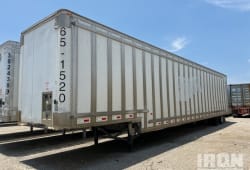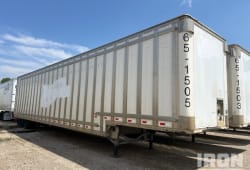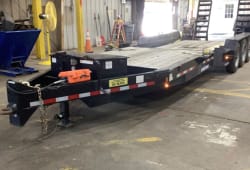10 Types of Oil and Gas Drilling Machines
8 Lectura mínima
)
septiembre 4, 2023
Discovering new sources of oil and gas is a complex endeavor that relies on cutting-edge technology and specialized machinery. In the world of energy exploration, various drilling machines take center stage, each uniquely designed to conquer specific challenges. From the advanced capabilities of drillships that venture into deep waters to the time-honored techniques of cable tool rigs, and the efficiency of auger and rotary drills, this blog delves into the realm of 10 essential oil and gas drilling machines. Join us as we uncover the mechanisms behind these vital tools driving the energy industry's progress.
Land Rigs: Exploring the Basics of Onshore Drilling
Land rigs are essential machines used in the oil and gas industry for extracting valuable resources from beneath the Earth's surface. These rigs are primarily deployed on land, making them the foundation of drilling operations. In this section, we'll delve into the fundamental components of land rigs and how they function.
Offshore Rigs: Conquering the Challenges of Deep Waters
Offshore drilling involves extracting oil and gas reserves located beneath the seabed. This type of drilling presents unique challenges due to the harsh marine environment and the complexities of working in deep waters. Offshore rigs come in various types, each designed to address specific conditions and requirements.
Types of Offshore Rigs
1. Jack-up Rigs: Jack-up rigs are versatile platforms that can be raised above the water's surface using legs or "jacks." These rigs are suitable for shallow-water drilling and are often used in coastal areas.
2. Semi-submersible Rigs: Semi-submersibles are floating structures with ballast systems that allow them to partially submerge. This enhances stability in rough seas and allows for drilling in deeper waters.
3. Drillships: Drillships are vessels equipped with drilling equipment. They can access remote offshore locations and drill in ultra-deep waters.
4. Tension-leg Platforms (TLPs): TLPs are anchored to the seabed with tensioned vertical tendons. They provide a stable platform for drilling in deep waters and can handle challenging conditions.
5. SPAR Platforms: SPAR platforms are cylindrical structures moored to the seabed with deep holes. They are designed to withstand extreme conditions and are commonly used for deepwater drilling.
Top Drive Rigs: Enhancing Efficiency and Control
Top drive rigs are a significant advancement in drilling technology. They replace the traditional rotary table and kelly, offering numerous benefits such as enhanced drilling efficiency, reduced wear on the drill string, and improved drilling control. Top drive systems are utilized both onshore and offshore, revolutionizing the way drilling operations are conducted.
Directional Drilling Machines: Navigating Complex Geology
Directional drilling machines are instrumental when drilling needs to deviate from the vertical path. This technique is employed when encountering complex geological formations or when drilling holes aiming to reach specific targets that are not directly beneath the drilling rig.
Benefits of Directional Drilling
1. Access to Remote Resources: Directional drilling allows access to resources that are not directly beneath the drilling site. This is particularly useful for offshore wells and those drilled in areas with limited surface access.
2. Maximized Reservoir Contact: By drilling horizontally through the reservoir, the well can have drilled holes intersect more of the productive rock formation. This increases production rates and enhances resource recovery.
3. Reduced Environmental Impact: Directional drilling can reduce the environmental footprint by minimizing the number and location of drilling sites needed to access multiple reservoirs.
Avoidance of Obstacles: Directional drilling can navigate around obstacles such as sensitive ecosystems, urban areas, or existing infrastructure.
Jack-up Rigs: Adapting to Shallow Waters
Jack-up rigs are a common sight in shallow-water drilling operations. These rigs are designed to be mobile and can be towed to drilling locations. Once on-site, they raise their hulls above the water level using retractable legs.
Jack-up Rig Mechanics
1. Leg Deployment: To prepare the jack-up rig for drilling, the rig's legs are lowered to the seabed. This provides stability during drilling operations.
2. Elevated Position: After the legs are firmly on the seabed, the rig's hull is raised above the water surface. This elevation prevents wave interference with drilling activities.
3. Drilling Operations: With the hull elevated, the drilling operation can commence. The rig's equipment and components are housed on the deck, making it easier to manage operations.
Drillships
Combining Mobility and Capability
Drillships represent a remarkable innovation in the field of oil and gas exploration. These cutting-edge machines combine unmatched mobility with exceptional drilling capabilities, making them indispensable for offshore drilling operations. Drillships are self-propelled vessels equipped with advanced drilling equipment, making them a preferred choice for deepwater exploration and production.
Deepwater Exploration with Drillships
Drillships have revolutionized deepwater exploration by enabling drilling activities in remote and challenging offshore environments. Their dynamic positioning systems ensure precise positioning, even in rough seas, allowing drilling to be performed at unprecedented depths. With advanced drilling technologies onboard, drillships extract valuable hydrocarbons from beneath the ocean floor, contributing significantly to the energy industry's expansion.
Cable Tool Rigs
Traditional Drilling Technique
Cable tool rigs, also known as percussion rigs, represent a traditional drilling technique that has stood the test of time. These rigs operate by repeatedly raising and dropping a heavy drill bit to break through rock formations. While not as swift as modern rotary drilling, cable tool rigs are preferred in certain scenarios due to their reliability, speed, and cost-effectiveness.
Cable Tool Rig Process
The cable tool rig process involves a bit that is attached to a thick cable. This bit is raised and then dropped onto the rock surface repeatedly, gradually creating a hole. Debris is removed using a bailer, and the process continues until the desired diameter and depth are achieved. While this method may be slower compared to newer technologies, its simplicity and effectiveness make it a valuable option for specific drilling projects.
Auger Drills
Well-suited for Soft Ground
Auger drills are highly efficient when drilling through soft ground formations. These machines employ a helical screw blade, known as an auger, to create a hole. The rotation of the auger removes soil, allowing for smooth and continuous drilling through the existing hole. Auger drills are commonly used in construction and environmental drilling, where the ground is relatively soft and easy to penetrate.
Auger Drilling Advantages
Auger drilling offers several advantages, particularly in environments with soft or unconsolidated ground. The simplicity of the design and the ability to remove cuttings easily make auger drills a practical choice. Additionally, auger drills are less likely to collapse and drill holes in loose formations, contributing to safer and more efficient drilling operations.
Rotary Drilling Machines
Versatile and Widely Used
Rotary drilling machines are among the most versatile and widely used drilling equipment in the oil and gas industry. These machines utilize the power of a rotating drill bit to create a hole by chipping away at the rock formation. The drill bit is attached to a string of drill pipes that allows for the circulation of drilling fluids to cool and lubricate the bit.
Rotary Drilling Process
The rotary drilling process involves the rotation of the drill bit while applying downward pressure. As the drill head of the bit grinds through the rock, drilling fluids are pumped down the drill pipe to carry cuttings to the surface. This continuous circulation prevents the hole from collapsing and maintains stability. Rotary drilling is efficient and suitable for various geological formations, making it a staple in oil and gas exploration.
Conclusion
In the dynamic realm of oil and gas extraction, employing the right drilling machine is paramount. From versatile drilling rigs to cutting-edge jack-up rigs and mobile offshore drilling units, each plays a pivotal role in accessing geologic reservoirs. Whether it's the exploration wells delving into uncharted territories or the drilling operations targeting existing holes, the machinery's precision is what unlocks the potential of vast natural gas and oil reserves. In this intricate dance of technology and resource exploration, the choice of drilling equipment becomes the linchpin, ensuring that every drop of oil and every cubic meter of natural gas are harnessed efficiently from the Earth's depths.

Mike Kennedy is Boom & Bucket's Marketplace Operations Manager, where he leads shipping, warranties, and post-sale operations to create a seamless buyer experience. As one of the company's earliest team members, Mike helped build the foundation of Boom & Bucket's operations and guided its growth through acquisition by RB Global. He is passionate about scaling marketplaces, solving operational challenges, and improving efficiency to deliver industry-leading results.














